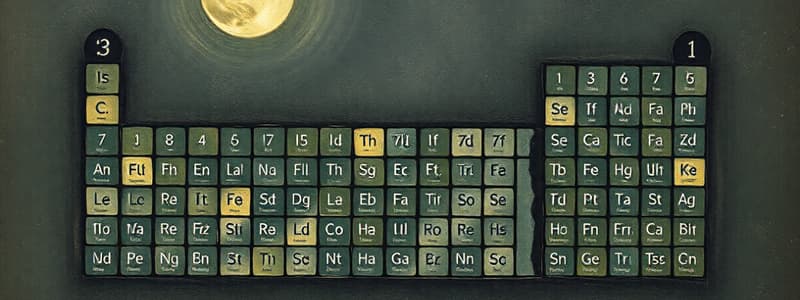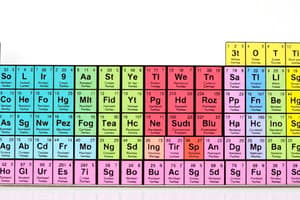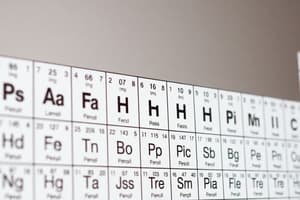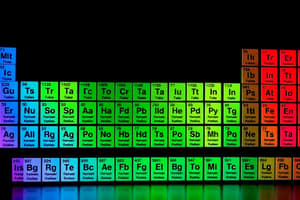Podcast
Questions and Answers
What happens to the metallic character of elements as you move from left to right across a period in the periodic table?
What happens to the metallic character of elements as you move from left to right across a period in the periodic table?
- It increases significantly.
- It fluctuates wildly.
- It decreases. (correct)
- It remains constant.
Which statement correctly describes the number of valence electrons for elements in the same group?
Which statement correctly describes the number of valence electrons for elements in the same group?
- They all have one valence electron.
- They have the same number of valence electrons as the period number.
- They have the same number of valence electrons equal to the group number. (correct)
- They have varying numbers of valence electrons based on atomic number.
What does the period number of an element represent?
What does the period number of an element represent?
- The number of shells around the nucleus. (correct)
- The number of protons in the atom.
- The total number of electrons in the atom.
- The number of valence electrons in the outer shell.
How can the chemical properties of elements in the same group be characterized?
How can the chemical properties of elements in the same group be characterized?
Which of the following elements has 7 electron shells and is in group 4?
Which of the following elements has 7 electron shells and is in group 4?
What is the maximum number of electrons that can occupy the outermost shell of an atom?
What is the maximum number of electrons that can occupy the outermost shell of an atom?
Isotopes of an element have the same number of which of the following subatomic particles?
Isotopes of an element have the same number of which of the following subatomic particles?
Which of the following statements about isotopes is true?
Which of the following statements about isotopes is true?
What role does the Periodic Table play in chemistry?
What role does the Periodic Table play in chemistry?
Which of the following isotopes is radioactive?
Which of the following isotopes is radioactive?
What uniquely characterizes radioactive isotopes compared to non-radioactive ones?
What uniquely characterizes radioactive isotopes compared to non-radioactive ones?
How are transition metals different in terms of electron configuration compared to other elements?
How are transition metals different in terms of electron configuration compared to other elements?
Which statement about the outermost shell's capacity is accurate?
Which statement about the outermost shell's capacity is accurate?
What are the three types of sub-atomic particles that make up an atom?
What are the three types of sub-atomic particles that make up an atom?
What does the atomic number of an element represent?
What does the atomic number of an element represent?
In the structure of an atom, where are electrons located?
In the structure of an atom, where are electrons located?
What is defined as the total number of protons and neutrons in an atom’s nucleus?
What is defined as the total number of protons and neutrons in an atom’s nucleus?
Which statement about the electronic structure of an atom is correct?
Which statement about the electronic structure of an atom is correct?
What is the mass of electrons compared to protons and neutrons?
What is the mass of electrons compared to protons and neutrons?
How is the mass number of an atom calculated?
How is the mass number of an atom calculated?
What is true about the valence shell of an atom?
What is true about the valence shell of an atom?
What is the main reason that noble gases are considered unreactive?
What is the main reason that noble gases are considered unreactive?
Which of the following elements is classified as a liquid non-metal at room temperature?
Which of the following elements is classified as a liquid non-metal at room temperature?
Which property is characteristic of metals?
Which property is characteristic of metals?
What is the electron configuration of helium in terms of electrons in its outer shell?
What is the electron configuration of helium in terms of electrons in its outer shell?
What type of ions do non-metals typically form when they react?
What type of ions do non-metals typically form when they react?
Where are metals generally located in the periodic table?
Where are metals generally located in the periodic table?
Which of the following statements about the elements of Group I is correct?
Which of the following statements about the elements of Group I is correct?
Which characteristic is NOT true for non-metals?
Which characteristic is NOT true for non-metals?
Why is helium preferred over hydrogen for filling weather balloons?
Why is helium preferred over hydrogen for filling weather balloons?
Which of the following correctly identifies a positive ion?
Which of the following correctly identifies a positive ion?
Which statement correctly describes transition metals?
Which statement correctly describes transition metals?
What determines the identity of an atom?
What determines the identity of an atom?
Which of the following pairs exemplifies elements not arranged by mass number?
Which of the following pairs exemplifies elements not arranged by mass number?
What describes the physical properties of transition metals?
What describes the physical properties of transition metals?
Why are bridges typically made of iron instead of aluminum?
Why are bridges typically made of iron instead of aluminum?
What would happen to the atomic size as neutrons increase?
What would happen to the atomic size as neutrons increase?
What is the main reason for using aluminium in the body of an airplane?
What is the main reason for using aluminium in the body of an airplane?
What is a characteristic of compounds?
What is a characteristic of compounds?
Which of the following salts is considered to be colored?
Which of the following salts is considered to be colored?
Which of the following statements is true regarding mixtures?
Which of the following statements is true regarding mixtures?
What distinguishes metals from non-metals in the periodic table?
What distinguishes metals from non-metals in the periodic table?
What occurs to the reactivity of non-metals as you move across a period in the periodic table?
What occurs to the reactivity of non-metals as you move across a period in the periodic table?
Why are compounds generally more stable than individual atoms?
Why are compounds generally more stable than individual atoms?
What defines the transition metals in terms of their properties?
What defines the transition metals in terms of their properties?
Flashcards
What is an atom?
What is an atom?
The smallest unit of an element that retains the chemical properties of that element. It's composed of protons, neutrons, and electrons.
What is an element?
What is an element?
A pure substance composed of atoms with the same atomic number. They cannot be broken down into simpler substances.
What is atomic number?
What is atomic number?
The number of protons found in the nucleus of an atom. It determines the element's identity.
What is mass number?
What is mass number?
Signup and view all the flashcards
What are protons?
What are protons?
Signup and view all the flashcards
What are neutrons?
What are neutrons?
Signup and view all the flashcards
What are electrons?
What are electrons?
Signup and view all the flashcards
What is electronic structure?
What is electronic structure?
Signup and view all the flashcards
Metals
Metals
Signup and view all the flashcards
Non-metals
Non-metals
Signup and view all the flashcards
Group Number
Group Number
Signup and view all the flashcards
Period Number
Period Number
Signup and view all the flashcards
Metallic Character
Metallic Character
Signup and view all the flashcards
What is the valence shell?
What is the valence shell?
Signup and view all the flashcards
What is the octet rule?
What is the octet rule?
Signup and view all the flashcards
What are isotopes?
What are isotopes?
Signup and view all the flashcards
How do isotopes differ in terms of chemical and physical properties?
How do isotopes differ in terms of chemical and physical properties?
Signup and view all the flashcards
What is the difference between radioactive and non-radioactive isotopes?
What is the difference between radioactive and non-radioactive isotopes?
Signup and view all the flashcards
What are some uses of radioactive isotopes?
What are some uses of radioactive isotopes?
Signup and view all the flashcards
What is the periodic table?
What is the periodic table?
Signup and view all the flashcards
How are elements arranged in the periodic table?
How are elements arranged in the periodic table?
Signup and view all the flashcards
Noble (Inert) Gases
Noble (Inert) Gases
Signup and view all the flashcards
Alkali Metals
Alkali Metals
Signup and view all the flashcards
Halogens
Halogens
Signup and view all the flashcards
Earth Alkali Metals
Earth Alkali Metals
Signup and view all the flashcards
Why is helium used in weather balloons instead of hydrogen?
Why is helium used in weather balloons instead of hydrogen?
Signup and view all the flashcards
What is a negative ion?
What is a negative ion?
Signup and view all the flashcards
What is a positive ion?
What is a positive ion?
Signup and view all the flashcards
How do you identify an atom?
How do you identify an atom?
Signup and view all the flashcards
What stays the same when an atom forms an ion?
What stays the same when an atom forms an ion?
Signup and view all the flashcards
What are some physical properties of transition metals?
What are some physical properties of transition metals?
Signup and view all the flashcards
Why do transition metals form colored compounds?
Why do transition metals form colored compounds?
Signup and view all the flashcards
What is a catalyst and how do transition metals act as catalysts?
What is a catalyst and how do transition metals act as catalysts?
Signup and view all the flashcards
Compound
Compound
Signup and view all the flashcards
Mixture
Mixture
Signup and view all the flashcards
Valence Shell
Valence Shell
Signup and view all the flashcards
Study Notes
Atomic Structure
- Atoms are the fundamental building blocks of all elements.
- Atoms are spherical in shape and composed of subatomic particles: protons, neutrons, and electrons.
- The nucleus, at the atom's center, contains protons (positive charge) and neutrons (no charge).
- Electrons (negative charge) orbit the nucleus in different energy shells.
- Nucleons are protons and neutrons, concentrated in the nucleus.
- The atom is electrically neutral because the number of protons equals the number of electrons.
- Valence electrons are in the outermost shell and participate in chemical reactions.
- Atomic mass is primarily concentrated in the nucleus.
Elements
- An element is a pure substance composed of identical atoms.
- Elements are characterized by their atomic number (Z), which is the number of protons in the nucleus.
- Each element has a unique symbol, atomic number, and mass number (A), the total number of protons and neutrons.
- The atomic number uniquely identifies an element.
- Mass number is the sum of protons and neutrons in an atom.
Isotopes
- Isotopes are atoms of the same element with the same number of protons but different numbers of neutrons.
- They have the same atomic number but different mass numbers.
- Isotopes have identical chemical properties but different physical properties.
Electronic Configuration
- The electronic configuration describes the arrangement of electrons in different energy shells surrounding the nucleus.
- Electrons fill shells closest to the nucleus first.
- The maximum number of electrons in each shell follows the rule 2n².
- The outermost shell is called the valence shell, and its electrons are involved in chemical reactions.
- The periodic table is helpful for predicting electronic configurations.
Periodic Table
- The periodic table organizes elements based on increasing atomic numbers.
- Elements are grouped into periods (rows) based on the number of electron shells.
- Elements in the same group have similar properties and the same number of valence electrons.
- Metallic character generally decreases across a period, and increases down a group.
- Non-metals generally increase across a period, and decrease down a group.
- The noble gases (Group 0/Group 18) are virtually unreactive due to their filled valence electron shells.
Properties of Transition Metals
- Transition metals are generally dense, strong, and have high melting points.
- Some transition metals form colored compounds and can act as catalysts.
- Many transition metals have more than one oxidation state.
Ions
- Ions are charged atoms formed by gaining or losing electrons.
- Positive ions (cations) are formed by losing electrons (protons > electrons).
- Negative ions (anions) are formed by gaining electrons (electrons > protons).
Studying That Suits You
Use AI to generate personalized quizzes and flashcards to suit your learning preferences.




